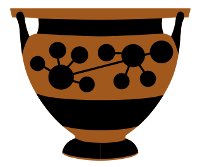Ontology
After much discussion of the Kerameikos list, we are moving forward with the initial proposed set of classes in the ontology, plus one: ProductionPlace. A production place in Kerameikos is a theoretical concept. It may be as specific as a workshop, if it can be ascertained, or as generic as a large region, such as West Greece. Presently, there are four pottery-specific classes in the ontology besides ProductionPlace: Shape, Style, Technique, and Ware (still under debate). There are a variety of classes borrowed from CIDOC-CRM, such as E4_Period.The complexity of instances in the Kerameikos id namespace is variable. Shapes and places are relatively simple. Techniques, styles, and periods can be built from the ground up--starting simply, but with the potential for greater complexity. For example, the Black Figure technique is invariably composed incision and silhouette, also techniques. A style, like Marine Style, has a single identifier in a system like the Getty AAT, but is a combination of concepts: it is a particular decorative style from a particular place (Crete), culture (Minoan), and period (Late Minoan), which falls in the Bronze Age (which has vague absolute dates attached).
The Kerameikos editor allows for the creation and linking of these concepts on a simple level, but I am to extend the editing functionality to enable more complex typologies.
Concept Schemes
Previously, the Kerameikos id namespace (http://kerameikos.org/id/) was the landing page for browsing the collection, but it now resolves to a skos:ConceptScheme. It is possible to use content negotiation to get this scheme in RDF/XML, Turtle, and JSON-LD. The browse page has been moved to the browse/ pipeline.The introduction of concept schemes into Kerameikos.org will enable the next iteration of ids. We plan to begin attributing concepts in the id namespace to bibliographic references, i. e., to link painters and potters to references that identify them. This means that in the near future, we'll introduce a 'work' concept scheme. We'll be able to link ids to Worldcat or JSTOR URIs. In the case of Worldcat, at least, we'll be able to extract bibliographic and authority RDF metadata from OCLC. The attribution of ids is absolutely necessary for the project, and will likely open up other avenues of inquiry. In the future, one might get a list of all painters identified by John Beazley or identify all vases found in Vulci that were published in 1890-1900.
